| |
Driver's license
Car Show
Driver's license
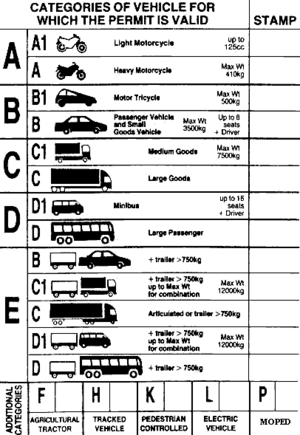 Driving licences within the
European Union are subdivided into different categories.
Driving licences within the
European Union are subdivided into different categories.
A driver's license (UK, Hong Kong, Singapore:
driving licence;
U.S.:
driver's license or driver license;
Canada, Australia, New Zealand: driver's licence) is an official document which states that
a person has the necessary qualifications to
operate a motorized vehicle, such as a motorcycle,
car,
truck, or a bus. Driver's
licenses are generally issued after the recipient has passed a successful
driving test and proven that they meet the age requirement. Different categories
of licenses may exist for different types of motor vehicles. The difficulty of
the driving test may vary considerably between jurisdictions.
Country specifics
European Union after standardisation in 1998
 current EU driving licence, German version - front
current EU driving licence, German version - front
1. Family name
2. Given name(s)
3. Date and place of birth
4a. Issuing date
4b. Expiry date
4c. Issuing authority
5. Licence number
7. Signature of bearer
9. Categories
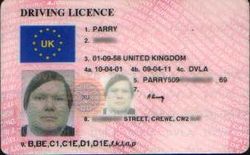 British version - front
British version - front
Key as above, additionally
8. Address
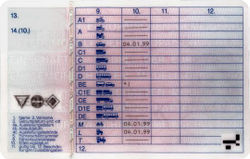 German version reverse
German version reverse
9. Licence categories
10. Issue date of the category
11. Expiry date of the category
12. restrictions (number coded)
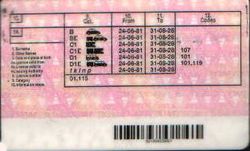 British version reverse
British version reverse
Key as above.
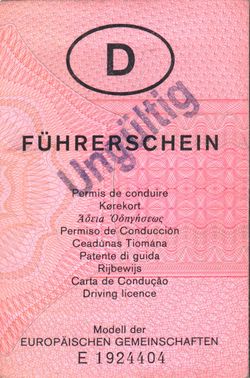 Front of the pre-1998 pink paper EC driving licence (German version with stamp:
"VOID")
Front of the pre-1998 pink paper EC driving licence (German version with stamp:
"VOID")
In most European
countries a person must be at least 17 or 18 years old to drive a car[1].
Some categories like C and D will be issued for 5 years only. After
expiration there is medical checkup necessary in order to renew the licence for
another 5 years.
Notably, the
Republic of Ireland has not moved to the post-1998 EU system and still
issues licences of the old type. It has no intention to move to a newer system
in the foreseeable future.
In March 2006, the Council of Ministers approved plans to create a single
European driving license to replace the 110 different models currently in
existence throughout the EU. The plans are supported by the European Commission
and the European Parliament meaning a law should be in place by the end of 2006.
National licenses will then be phased out between 2012 and 2032.[2].
(BBC)
Categories valid in all EU countries
- Category A: Motorcycles.
- Category A limited: Motorcycles up to a maximum power of 25
kW.
- Category A1: Light Motorcycles with a maximum displacement of
125 cm³ and a maximum power of 11 kW (minimum age: 16 years; speed limit
of 80 km/h in some countries).
- Category B: Passenger vehicle with a maximum mass of 3.5 t and
not more than 8 seats (excluding the driver); with a trailer with a maximum
mass of 750 kg, or the mass of an empty car if the total mass of both is
less than 3.5 t.
- Category C: Vehicles of more than 3.5 t mass and not more than 8
+ 1 seats (lorry); with a trailer with a maximum mass of 750 kg.
- Category C1: light lorry with a mass not more than 7.5 t;
with a trailer with a maximum mass of 750 kg.
- Category D: Vehicles with more than 8 + 1 seats (buses).
- Category D1: light buses with a maximum of 16 + 1 seats.
- Category E (combined only with B, C, C1, D or D1): other trailers
which are heavier than 750 kg. In combination with C1E and D1E, the maximum
total mass of vehicle and trailer is 12 t and the mass of the empty vehicle
must be higher than the mass of the trailer. Carrying passengers in a
trailer of category D1E is prohibited.
Furthermore there are more national categories for tractors, very light
motorcycles, motorised wheel chairs, motor tricycles (modern
voiturettes,
Category B1 or S) and military categories such as for driving
tanks.
Note for sample licence right: German driving licences do not have a
licence expiry date (number 4b on the licence) since they are issued for
lifetime (exept categories C and D, for which a mandatory medical check is
required at age 50, and every 5 years after then).
United Kingdom
The driving age for a car or van is 17 (unless in receipt of a full
disability allowance, when you can obtain a provisional licence at the age of 16
years), while a moped
or restricted-power motorcycle can be ridden at 16[3].
Until a driving test has been passed (which consists of three sections: a
theory test, a hazard perception test, and a supervised driving examination) a driver will hold a Provisional Licence and
must display learner plates (a large red L on a white background, or
optionally a large red D on a white background if the learner does not
leave Wales) on the front and back of the vehicle. They must also be accompanied
by an adult who is at least 21 years of age and has held a full driving licence
for at least three years.
[1] If a person holding a provisional licence receives points on his/her
licence, they will be unable to drive for six months, no matter how many points
they may receive.
Registration was introduced in 1903 with the
Motor Car Act. Competency tests were introduced in 1934 by the Motor Vehicles
Regulations 1935; they were suspended in 1939 for seven years due to the Second
World War and in 1956 for one year due to the Suez Crisis. The only person in
the United Kingdom who is not required to have a driving licence in order to
drive is the Queen. She also does not require number plates on any of her cars.
[4]
Until July 1998
[5], mainland Great Britain driving licences did not have photographs.
Anyone who holds a licence issued before this date may retain their photo-less
licence until expiry (normally one's seventieth birthday) or until they change
address, whichever comes sooner. The new "photocard" driving licences are a
two-part document, a plastic photocard which has to be renewed every ten years,
and a paper sheet (the "Counterpart Driving Licence") which is valid until the
holder's seventieth birthday.
Points are given for traffic offences, e.g. typically three or four points
for a speeding offence. Points remain on the licence for three years from
conviction - twelve points on the licence (6 points or more for those within 2
years of passing their test) leads to automatic suspension. In the case of
particularly egregious offences, the court may order the driver to pass the
driving test again before the licence is returned.
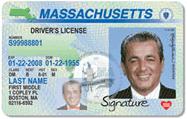 A
Massachusetts state example driver's license.
A
Massachusetts state example driver's license.
United States and
Canada
In the U.S. and Canada, the driving age is determined by the state or
province, with the most common age being sixteen[6].
Most states and provinces also have restricted driver's licenses (also called
learner's permits), which allow a person to drive provided they are accompanied
by a licensed driver. There has also been a trend toward "graduated driver's
licenses," in which new (especially young) drivers are gradually allowed more
driving privileges instead of being given complete driving privilege all at
once.
Learner's permits are granted by some states to drivers as young as
fourteen. Some states also issue farm permits or school permits to certain 14 or
15 year old drivers.
All U.S.
states have a minimum driving age of exactly sixteen, except for these
states:
Alaska: Small Motorcycle: 14 years; Automobile: 14 years (Learner's Permit) /
16 years (License)
Connecticut: 16 years, 6 months
Hawaii: 18 years
Idaho : 15 years (in daylight)
Indiana: 16 years, 1 month
Kansas: 14 years, with parent
Maryland: 16 years, 3 months
Massachusetts: 16 years, 6 months
Michigan: 14 years, 9 months (with parent)
Mississippi: 15 years
Montana: 15 years
New Jersey: 17 years (with some restrictions)
New York: 17 years (with drivers ed)
South Carolina: 15 years
South Dakota: 14 years, 6 or 9 months (6am-10pm)
Virginia: 16 years, 3 months
In Canada:
- Quebec:
16 years[7]
- Learners permit: Available at age 16 (with adult consent), with the
passing of a multiple choice road theory test, a driving permit is
issued which allows the learning driver to drive on roads accompanied by
someone with full valid driver's license.
- Probationary licence: Available after having held a learners permit
for 12 months or 8 months if the driver has completed a certain number
of driving lessons with recognized driving school. Probationary licence
is aquired after successfully completing a road test.
- Driver's licence: Finished a two year probationary period, if aged
16-24; or if the driver has passed the probationary licence driving
test, if age 25 or older.
- Ontario:
16 years
- Learners permit (G1): Available at age 16, with the passing of a
multiple choice road theory test, a driving permit is issued which
allows the learning driver to drive on roads accompanied by someone with
full valid driver's license who's
BAC is less then .05 and has been fully licenced for four years. The
driver also cannot drive on large devided highways or between 12:00 AM -
5:00 AM and must maintain their own BAC at zero.
- Probationary licence (G2): Available after having held a learners
permit for 12 months or 8 months if the driver has completed a certain
number of driving lessons with recognized driving school. Probationary
licence is aquired after successfully completing a road test. At this
point the driver must still maintain a BAC of zero. As of 2005
drivers with a G2 licences can carry only one passenger under 19 for the
first six months and only 3 passengers under 19 there after.
- Full licence (G): After 1 year of possessing the G2 licence a driver
can take an additional road test that often includes driving on a four
lane devided highway. With successful completion they will obtain a full
licence which carries no restrictions and are not required to take any
further tests until 80 providing they renew their licence regularly.
Drivers 80 years of age and over must complete a vision and knowledge
test and participate in a 90-minute group education session to renew
their licence.
In Ontario, there was a recently proposed legislation to deny driver's
licenses to high school dropouts until they turned 18. It was meant as an
incentive for students to graduate.[8]
Decline in licensing among young people in the U.S.
In the past decade, fewer and fewer teenagers are getting driver's licenses.
According to a December 2004
Los Angeles Times article, only 43% of American 16- and 17-year olds had
licenses in 2002. By comparison, the percentage in 1982 was 52%. The rate is
even lower in some states (e.g., 9% in Missouri).
Other Information/Use as Identification
Most states require new drivers to complete both driver's education classes
(which include both classroom lectures and textbook lessons) and driver training
(behind the wheel lessons with a state-licensed driving instructor) in order to
earn a driver's license.
In the
United States and most of Canada, a driver's license has a unique number or
alphanumeric code issued by the Department of Motor Vehicles (or equivalent), a
photograph of the bearer, a copy of his or her signature, the address of his or
her primary residence, the type or class of license, restrictions and/or
endorsements (if any), the physical characteristics of the bearer (like height,
weight, hair color, and sometimes even skin color), and birthdate. In the U.S.,
Social Security numbers are becoming less common on driver's licenses, due to
identity theft concerns. Most states require that when a driver establishes
residence in a state, he or she must obtain a license issued by that state
within a certain timeframe.
The classes of licenses are usually organized so that Class A is usually the
license that indicates a person can drive the heaviest and largest vehicles. The
license held by the vast majority of ordinary drivers is Class C, D, or E
depending upon how the government sets the weight limits for each class.
Motorcycles are usually Class M, although some jurisdictions simply add an
endorsement permitting the holder to operate motorcycles as well as the class of
vehicle for which he or she is licensed.
Because there is no national
identity card in the United States, the driver's license is often used as the de
facto equivalent for completion of many common business (and governmental)
transactions. As a result, driver's licenses are the focus of many kinds of
identity theft. Driver's licenses were not always identification cards. Indeed,
in many states, drivers licenses did not even have a photograph well into the
1980s. Thanks to pressure from Mothers Against Drunk Driving, who demanded the
use of photo ID age verification in conjunction with increasing the drinking age
to 21 in order to protect the public from drunk drivers, photographs were added
to all state licenses. New York and Tennessee were the last states to add photos
in 1986. Later additions, varying from state to state, have included
fingerprints, bar codes, magnetic strips, social security numbers, and allegedly
tamper-proof features, each new addition needed to protect against identity
theft, and to protect underage people using fake ID to purchase alcohol, and
more recently, in the war on terror.
Australia
Licensing laws in Australia differ between different states and territories;
however, most involve a similar procedure and a graduated licensing scheme.
In New South Wales, the minimum age for a Learner’s Permit is 16 for cars and
16 and 9 months for motorcycles. Since the introduction of an enhanced graduated
licensing scheme in 2000, new drivers must proceed through 3 different stages
before gaining a full, unrestricted licence. Allowing for the mandatory periods
of time between each licence, the effective minimum age of full licensing is 20.
The minimum age for a P1 licence is 17 and the mandatory periods of time
between each licence makes the effective minimum age of full licensing 20.
- A Learner's Permit, gained after passing a computerised knowledge
test. Learner drivers are permitted to drive accompanied by a full,
unrestricted licence holder (usually a parent or professional driving
instructor). Learner drivers are subjected to numerous restrictions: a
maximum speed of 80 km/h, a zero alcohol limit, cannot tow a trailer, and
must conspicuously display black-on-yellow 'L-plates' while driving. Learner
drivers must complete at least 50 hours (verified by a log book completed by
the supervising driver) of on-road driving experience, and must hold the
permit for at least six months, before they may apply for a Provisional (P1)
Picence. In an intentional quirk of the system, drivers may apply for a
Learner's permit at the age of 16, but the minimum age for a P1 licence is
17; drivers who apply for a Learner's permit on their sixteenth birthday
must therefore hold the licence for a year before progressing to the next
stage. This is thought to encourage extra driving experience for younger
applicants.
- A Provisional (P1) Licence is gained after six months and
successful completion of a practical driving test. The licence holder can
drive unaccompanied, but is limited to a maximum speed of 90 km/h, towing
trailers of up to 250kg, and a zero alcohol limit. They must display
red-on-white 'P-plates' while driving. P1 drivers are limited to a total of
three demerit points during the term of the licence, as compared to the
12-point limit on unrestricted licences. P1 drivers must hold the licence
for one year before progressing to the next stage.
- A Provisional (P2) Licence is gained after one year and
successful completion of a computerised hazard perception test. The driver
is restricted to a speed limit of 100km/h, a zero alcohol limit, and a
maximum of six demerit points; however, they are eligible to upgrade the
class of their licence, such as those for heavier vehicles. P2 drivers must
display a green-on-white 'P-plate' at all times. P2 drivers must hold the
licence for two years before progressing to the next stage.
- A full, unrestricted licence is gained after two years and
successful completion of another computerised test. Unrestricted drivers
progress through different "colour" licences: black, silver and gold.
There are several common complaints about the NSW licensing scheme. The
relatively high number of road accidents and traffic offences involving P-plate
drivers (such as speeding and drink-driving) has prompted calls for further
driving restrictions, such as curfews and passenger restrictions, as implemented
in other countries. Some consider 50 hours to be insufficient experience for
learner drivers. Also, the blanket speed restrictions on Learner and Provisional
drivers can pose problems on country roads and freeways, where learner drivers
are restricted to 80km/h while other drivers may travel up to 110km/h. In
Victoria, this problem is avoided by allowing learners to travel at higher
speeds on freeways.
In Western Australia, drivers who have had their licence revoked can obtain
an Extraordinary Licence if they can demonstrate that the loss of their
licence inflicts hardship and pay a
AUD$500 fine. The Extraordinary Licence permits them only to drive to avoid
the hardship, for example to and from work.
Tourists and visitors staying less than three months are permitted to drive
on the licence of their home country. If the licence is not written in English,
then an acceptable translation of the licence must be carried at all times.
Visitors staying more than three months must apply for a licence in the state in
which they reside.
In Australia, where there is no form of national
identity card, driver's licences serve as the primary means of photo
identification; 'proof of age' cards were available for non-drivers these have
been replaced by Photo cards from Dec 2005. Licences and Photo Cards are hologrammed, and contain a
photograph, signature, the driver's address and organ donor status.
As of 2005, Queensland licences are now called a "Driver Licence" (as opposed
to the traditional "Driver's Licence", or the more grammatically correct
"Driving Licence"), and no longer carry information about the holder's organ
donor status. The Australian Organ Donor Register[9]
is now used for national registration of tissue donation status, due to
criticism of the previous schemes.
New
Zealand
New Zealand has had a graduated driver licence system since 1987. It consists
of three phases for a car licence:
- Learner Licence, which is gained after scoring 32 out of 35 (or better)
on a multiple-choice test relating to road rules. Once gained, it allows a
driver to drive during daylight hours, provided they display black-on-yellow learner
plates and are accompanied by a "supervisor" (being any person who is
over 20 years of age and who has held a Full Licence for at least two
years). The learner license is a blue plastic card.
- Restricted Licence, which requires one having held a Learner Licence for
six months (three months if aged over 25) and passing a twenty-minute
practical driving test. This allows a driver to drive without L-plates, and
without a supervisor between 5am and 10pm if not carrying passengers. It is
a yellow plastic card.
- Full Licence, which requires having held a Restricted Licence for
eighteen months, or twelve months for someone who has taken a
defensive driving course (six and three months respectively for people
aged over 25), and passing a more thorough, hour-long driving test. It
allows a driver to drive at any time with passengers, and after two years to
supervise Learner and Restricted drivers. It is green plastic card.
Alternatively, people who gained a licence before 1987 (or holders of
overseas licences) can usually obtain a Full Licence without needing to take a
driving test.
A Learner licence can be applied for at age fifteen. This means the minimum
possible age to gain a Full Licence is sixteen and a half. In recent years,
there have been proposals to raise the minimum driving age to 16 or 17, but so
far they have never come to pass, due to objections from farmers who say that
their children need to learn to drive early in life because of limited public
transport.
The car licence allows the holder to drive a moped, tractor, or all-terrain
vehicle as well as a car, however, motorbikes and heavy vehicles
require separate licences.
Driver licences carry a unique identifying number, date of birth and
photograph of the holder, and apart from passports and a special-purpose 18+
card are the only legal form of ID for buying alcohol or tobacco. They also
carry a legend declaring whether or not the holder wishes to donate his or her
organs if he or she dies on the road, however, the
next-of-kin are consulted first and decide whether or not organs will be donated
regardless of the wishes of the licence-holder.
Drivers must carry their license at all times while driving. If they fail to
do so they may face a fine of
NZD55.
Switzerland
The minimum age limit is 18 for cars (14 for mopeds). In fact, the Learner's
Licence for cars is not given until at least the date of the applicant's 18th
birthday and is withheld until the theoretical exam is passed. Learner plates (a
magnetic or non-magnetic blue square with a white "L" on it) are to be used when
the driver is one whom holds a Learner's Licence. Trips driven by the Learner
Driver must be accompanied by an individual of at least 23 years of age who has
possessed a valid licence for at least three years. Motorways may be accessed
only by those who have "experience skills" and are "ready for the exam". Test
drives must not interfere with traffic as usual. The official licence is given
after an on-the-road exam, based on a successful theoretical examination. Public
roads require a driver's licence, while private roads can be driven without one,
subject to the land proprietor's consent.
Mainland of the
People's Republic of China
Minimum age varies from 18 (for cars) all the way up to 26 (for large buses).
Learner's licences, although granted, have little effect, as most training takes
place within the confines of specially-designed training areas inaccessible, on
paper, to the general motoring public. Previously, expressways were inaccessible
even for holders of a normal driver's licence if they did not possess the
licence for a full year; however, such a regulation has now been invalidated.
Drivers with licences less than a year old, however, are still considered
"intern drivers" or "new drivers" (in Chinese, 实习司机, shíxí siji), and
certain limitations apply to them (for example, they must display a uniform
label on the car when they are driving). The PRC considers the driving licence,
under a new law, an administrative licence (in Chinese, 行政许可, xíngzhèng xuke).
Norway
Minimum age for cars is 18 years.
Mopeds (50 cc)
and smaller motorcycles (engine capacity equal to, or less than 125 cubic
centimetres) is 16 years. Most larger truck licenses require holder to be 21
years old. Although Norway is not part of the EU, the license is in the form of
an EU license.
India
Each state has a "Regional Transport Authority" or RTO which issues licenses.
Minimum age is 16 years for small motorcycles (50cc or less) and 18 for all
other vehicles. Drivers have to appear for an oral test to get a learners
license which is valid for 12 months. Drivers can then pass a driving test to
get the drivers license.
Special licenses
In the United States and Canada, persons who drive commercially (especially
truckers and taxi drivers) are required to have special licenses. For taxicab
drivers, these licenses are usually called Chauffeur Permits. In most cases,
commercial truckers must hold a commercial driver's license or CDL. In the
United Kingdom, one must hold a Passenger Service Vehicle (PSV) license to drive
a bus carrying more than eight passengers, or a Large Goods Vehicle (LGV)
license to drive a truck (lorry) licensed to carry a weight greater than 3500
kg. Special licenses can also be required in order to transport hazardous
materials. The cost of taking the series of tests and examinations
to obtain these licenses usually means that an employer would subsidize their
drivers.
International considerations
The holder of a license from any
EU member country can
drive in any other EU country. Most countries worldwide will also recognize the
licenses of citizens of foreign states wishing to drive as visitors. All EU
member countries now issue licenses in a standard format, regardless of the
language of the license.
The
International Driving Permit (IDP) (sometimes erroneously called the
International Drivers' Licence) is a booklet which is an authorized
translation of a driver's home license into many languages (especially languages
with different scripts such as
Cyrillic, Arabic, Chinese, Japanese, etc.). In some cases, it is obtained from the
Automobile Association or equivalent organization in the driver's home
country; in other cases, it is delivered by the same government services that
deliver ordinary licenses. The IDP has no validity except when used in
conjunction with the driver's own license. The existence of the IDP is motivated
by many countries not recognizing driver's licenses written in foreign languages
and not coming with an authorized translation.
The
People's Republic of China at present does not recognize IDPs (although Hong
Kong and Macao do) and
requires drivers to get an additional PRC license before being officially
allowed on all roads.
Most licence issuing authorities require people who hold "foreign" driving
licences who move their residence to their area to obtain a local driving
licence within a limited time (typically 1 year), although European Union
drivers who move from one EU state to another can continue driving on their
original licences until age 70. In most cases, the driver will have to follow
the full local procedure for obtaining a licence, but some countries have mutual
recognition agreements and will exchange the foreign licence for a local one
without the need to take an additional driving test, e.g. U.S. states; Great
Britain will (as of 2006) exchange full licences issued by Australia, Barbados,
British Virgin Islands, Canada, Falkland Islands, Hong Kong, Japan, Monaco, New
Zealand, Singapore, South Africa, South Korea, Switzerland and Zimbabwe.
Use as identification
Because the United States and Canada have no national
identification cards and because of the widespread use of cars, drivers'
licenses are typically used in both countries as a form of identification. Most
state and provincial driver's license bureaus also issue identification cards
for nondrivers. It should be noted, however, that as of 2006 Americans are
required to present a passport for entry into Canada.
Many European countries require adults to carry an ID card at all times.
Citizens of the
UK and Ireland and other EU countries which have no national ID cards, have to
carry their passports
instead when travelling in these countries. In the PRC, the driver's license
number is synonymous with the ID number of a Chinese citizen (up to 18 digits
long).
Similarly,
Saudi
Arabia requires all drivers to carry an ID card in addition to a license,
and present them whenever requested. Using a driver's license instead is only
permitted if the request is made for on-site inspection/identification purposes,
especially at check points. Expats may be requested to present their visas too.
Miscellaneous
Under the U.S.
Uniform Anatomical Gift Act, the various states are encouraged to set up
programs through which licensed drivers can make organ donations for the purpose
of transplant
by a notation on their licenses.
Likewise, in the UK many choose to have an organ donation listed on their
license however it is by no means compulsory.
History
France and Germany were among the earliest countries to require mandatory
driver licensing, right at the start of the 20th century. As automobile-related
fatalities soared in North America, public outcry provoked legislators to begin
studying the French and German statutes as models[10].
On August 1, 1910, North America's first driver licensing law went into
effect in the U.S. state of New York, though it initially applied only to
professional chauffeurs
[11]. In
July of 1913, the state of New Jersey became the first to require all
drivers to pass a mandatory examination before receiving a license
[12].
References
- ↑
Minimum age for driving licence on webpage European Union
- ↑
Klartecken för EU-körkort. Svenska Dagbladet. URL accessed on
2006-03-27.
- ↑
UK driving licence info
- ↑
http://www.dvla.gov.uk/public/press_releases/2003/p_release_0303_18Feb03.htm
- ↑
http://news.bbc.co.uk/1/hi/uk/137238.stm
- ↑
U.S. Drivers License Info
- ↑
SAAQ
- ↑
Ontario to delay driver's licenses to dropouts
- ↑
http://www.medicareaustralia.gov.au/yourhealth/our_services/aaodr.htm
- ↑ Anonymous, "Better
Auto Laws Are Now Needed,"
New York Times, 18 August 1907, S3.
- ↑ Frederick H.
Elliott, "Working Out New Auto Law In New York,"
New York Times, 16 October 1910, 3.
- ↑ Anonymous, "New
York's Auto Exports Increase—Big Jump in Cars Shipped Last Year—New Jersey
Examines All Drivers,"
New York Times, 14 July 1913, 11.
External links
Home | Up | Driving under the influence | Driver's license | Radar detector | Road safety
Car Show, made by MultiMedia | Free content and software
This guide is licensed under the GNU
Free Documentation License. It uses material from the Wikipedia.
|
|







